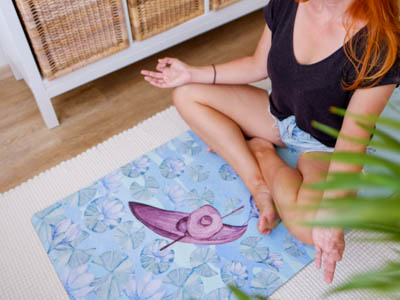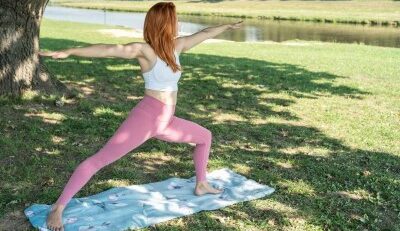Meditation – path to inner peace and self-knowledge
Meditation is gaining increasing popularity. It not only benefits mental well-being, but also has the ability to improve the quality of life. In this article, we will introduce the main types of meditation, practical ways to meditate, and what meditation tools are ideal for creating the right conditions. Whether you are seeking inner peace or a deeper spiritual connection, meditation is a tool worthy exploring.
What is meditation?
Meditation is a practice aimed at focusing on the present moment, calming the mind, and achieving inner peace. Most meditation techniques involve intentionally letting go of distracting thoughts and fully focusing on an object, the breath, or an internal experience. Meditation can take many forms and be practiced in various contexts. While traditionally meditation was practiced with a spiritual focus, today it is often used in the fields of health and wellness.
Benefits of meditation
Regular meditation offers a number of mental and physical benefits. It helps improve concentration, reduce stress, improve sleep, support emotional stability, and overall well-being. Here are some of the main benefits of meditation:
- Reduced stress and anxiety – Meditation is one of the most effective tools for alleviating stress. Techniques such as mindfulness or concentrative meditation help calm the mind and relax the body. Studies show that meditation can lower cortisol, the stress hormone, which positively impacts overall health and well-being.
- Improved concentration and focus – Regular meditation improves our ability to focus. Techniques that require focusing on a single point (such as the breath or a mantra) train the brain to become more focused and resistant to distractions. This effect also carries over into daily life, where you can maintain better focus at work or other activities.
- Support for mental balance and emotional stability – Meditation, especially Loving Kindness (Metta) meditation, helps develop positive emotions such as compassion, love, and gratitude. This practice leads to a better understanding of one’s own emotions and improves the ability to respond to stressful situations with calm. Mindfulness meditation also supports self-acceptance and helps improve the inner relationship with oneself, leading to greater emotional stability.
- Improved sleep quality – Meditation can significantly improve the quality of sleep. Relaxing the body and mind during meditation, especially before bedtime, helps calm the nervous system and reduce anxiety and tension that often hinder quality sleep. Regular meditation practice can lead to deeper, more restorative sleep.
- Enhanced creativity and inner clarity – Meditation also helps improve creativity and mental clarity. When you let go of internal chaos and distracting thoughts, your mind becomes clearer and more open to new ideas. Visual and guided meditations are particularly effective in supporting creative processes.
- Improvement in overall health – Meditation also positively impacts physical health. Studies suggest that regular meditation can improve immune system function, lower blood pressure, enhance cardiovascular health, and alleviate pain. It also helps improve respiratory function and promotes overall relaxation of the body.
Types of meditation
There are a variety of meditation techniques. Some focus on mental and emotional aspects, while others focus on physical health. Here are some of the most common types of meditation and what they involve:
- Concentrative Meditation
Concentrative meditation is a common technique that involves focusing attention on a single object, sound, or thought. It could be your breath, a candle flame, the sound of Tibetan singing bowls, or a mantra. The goal is to clear the mind of distracting thoughts and achieve deep concentration. This type of meditation is ideal for those who want to learn to focus and improve their attention. - Mindfulness Meditation
Mindfulness meditation, also known as Vipassana meditation or Insight meditation, is a practice focused on full awareness of the present moment. Mindfulness means being aware of every thought, feeling, and sensation without judging or becoming overwhelmed by them. This type of meditation helps improve concentration, reduce stress, and increase the ability to accept situations as they are, without prejudice. - Transcendental Meditation (TM)
Transcendental Meditation involves repeating a specially chosen mantra. This meditation leads to deep relaxation and calm. Known for its simplicity, TM is highly effective for reducing stress, improving concentration, and enhancing mental well-being. The goal is to achieve a state of calm awareness where the mind is relaxed but still alert. - Visual Meditation with Guided Meditation
In visual meditation, you imagine certain images, scenes, or symbols. It could be a picture of serene nature, a glowing orb, or various geometric shapes. This meditation is often combined with guided instructions. Guided meditation is excellent for beginners. The meditator is led through the meditation process by guide’s instructions or recording. Visual meditation helps release tension, improve mental clarity, and boost creativity. It is ideal for those who enjoy vivid imagery and mental visualization. - Movement Meditation
Movement meditation is a practice that combines meditation with physical movement. This type of meditation involves slow, conscious, and focused movements of the body, which help release tension and create inner calm. One of the most common forms of movement meditation is yoga. Each posture (asana) is performed with full attention to the breath and bodily sensations. Yoga not only improves flexibility and strength but also supports mental balance and focus. Movement meditation is great for those who struggle to stay still for long periods or want to combine meditation with physical activity. - Loving Kindness Meditation (Metta Meditation)
Loving Kindness Meditation, also known as Metta meditation, is a practice focused on developing a loving and compassionate attitude towards oneself and others. The goal is to spread positive energy, compassion, and kindness—both towards oneself and others, including those you may not know or with whom you may have difficulties. This type of meditation helps improve relationships, increases empathy, and promotes positive thinking. Metta meditation is an excellent way to enhance emotional well-being and compassion in everyday life.
Meditation tools, props and accessories
Using meditation tools can significantly enhance your meditation practice and make it more comfortable. Regular use of props also helps make meditation a ritual or healthy habit. Here are a few tips for creating ideal conditions for meditation:
Ways to meditate
You can practice meditation in different ways depending on your preferences, capabilities, and needs. Some techniques require stillness and focus, while others may include movement.
- Seated Meditation
Seated meditation is the traditional and most common form of meditation. You sit in a comfortable, stable position, often in a lotus or half-lotus pose. This form of meditation supports focus while allowing the body to remain upright. Use a meditation cushion like the Zafu cushion to help maintain proper posture and increase comfort during long sitting sessions. - Lying Down Meditation
If sitting is uncomfortable or if you have back issues, you can meditate lying down. Although this form of meditation is comfortable, it’s important to stay alert so you don’t fall asleep. Lying down is ideal for relaxation or for those who prefer to meditate before bedtime. - Movement Meditation and Yoga
Movement meditation is perfect for those who want to enjoy meditation in combination with physical exercise. Yoga is one of the most common forms of movement meditation, integrating breath, body positions, and awareness. Movement meditation is ideal for those who need relaxation while staying active. - Walking Meditation
Walking meditation is a great way to practice meditation outdoors. This practice involves slow, conscious walking where you focus on each step and the sensations it brings. Walking meditation is perfect for those who find it difficult to meditate in stillness and prefer movement.
How to start meditating?
If you are new to meditation, start slowly. You don’t need to sit for hours in a lotus position wondering if it’s enough. Begin with just a few minutes and gradually increase the time. Let your feelings guide you. Choose the type of meditation that suits you best.
If you choose seated meditation, we recommend using a comfortable meditation cushion like the Zafu cushion, which will provide support for your body and spine, preventing pain and discomfort during long sitting sessions. Often, regardless of the type of meditation, scented candles, crystals and incense can help create the right atmosphere, promote relaxation, and increase sensitivity to higher vibrations. If you’re meditating outdoors, a portable towel is enough, as it’s compact and doesn’t take up much space. If you enjoy yoga, consider using an exercise mat to help perform asanas with more stability and comfort. And if you’re feeling tired or stressed, use a relaxing eye pillow to relieve tension and calm your mind.
Conclusion
Meditation is a powerful tool for improving mental well-being, calming the mind, and achieving inner balance. Whether you choose concentrative, mindfulness, or visual meditation, regular practice offers not only immediate relief but also long-term benefits. With the help of quality tools, you can further enhance your practice and create the ideal conditions for deep experience.
Start today, take a moment of calm, and discover the positive effects meditation can have on your daily life.








Leave a Reply